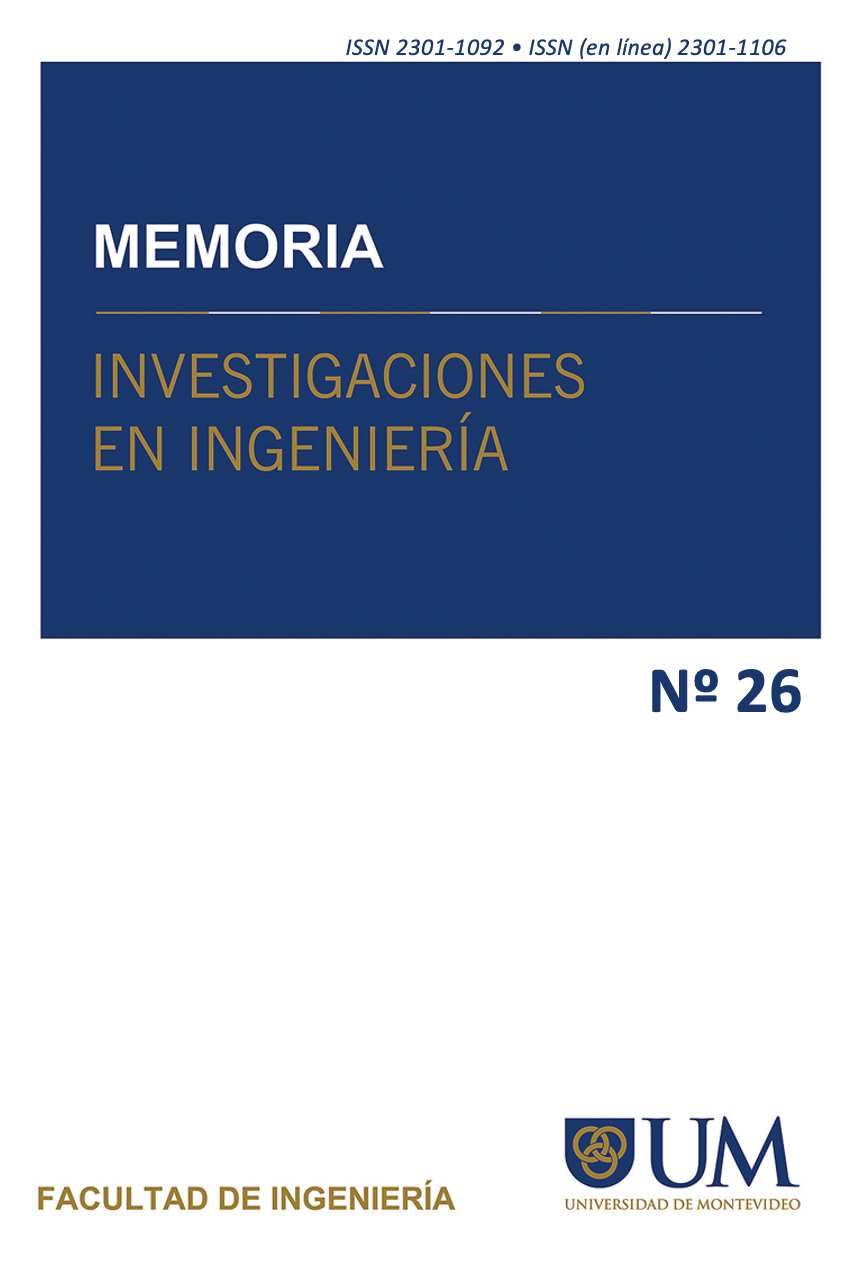Reducción del consumo de energía del compresor de refrigerador mediante nanopartículas de óxido de aluminio
DOI:
https://doi.org/10.36561/ING.26.3Palabras clave:
Refrigeración, Nanopartículas, Lubricante, Compresor, EnergíaResumen
La refrigeración se ha convertido en una parte integral de nuestra vida diaria y puede considerarse como un proceso cuya sustitución es casi imposible. Por tanto, la única forma de hacer eficiente este proceso es reduciendo el consumo energético de los componentes de los frigoríficos. Una forma de hacerlo es reducir el consumo de energía del compresor mediante la adición de nanopartículas en un refrigerante o en un lubricante. Este estudio se centra en la producción de nanolubricante (Al2O3/lubricante sintético) y la dispersión del nanolubricante en el compresor R-134a. Este estudio investiga cuánta energía se puede reducir cuando las nanopartículas de óxido de aluminio (Al2O3) se dispersan en el lubricante SL-32 (líquido base). Se realizó una comparación entre el lubricante SL-32 con y sin la adición de nanopartículas de óxido de aluminio y mostró una reducción del 0,913% en el consumo de corriente y del 2,74% en la potencia a la misma temperatura inicial de 31°C en ambos casos. Por lo tanto, se puede concluir que las nanopartículas de alúmina se pueden utilizar para reducir la energía utilizada por los compresores mediante la creación de un nanolubricante con lubricante SL-32.
Descargas
Citas
S. Comstock, "HALOCARBON REFRIGERATION SYSTEMS," in ASHRAE HANDBOOK, Atlanta, Stephen Comstock, 2014, p. 1.
W. F. Stoecker, "Applications of Refrigeration and Airconditioning," in Refrigeration and Air conditioning (2nd Edition), McGraw-Hill, 1986, p. 12.
Y. A. Cengel, "THE SECOND LAW OF THERMODYNAMICS," in Thermodynamics: An Engineering Approach (5th Ed), McGraw-Hill, 2006, p. 287.
Stephen U. S. Choi and J. A.Eastman, "Enhancing thermal conductivity of fluids with nano particles," ASME International Mechanical Engineering Congress & Exposition, 1995.
A. Majgaonkar, "Use of nanoparticles in refrigeration systems: a literature review paper," in International Refrigeration and Air Conditioning Conference, 2016.
M. Hatami and D. Jing, Nanofluids: Mathematical, Numerical, and Experimental Analysis, Elsevier, 2020.
G. H. Hundy, A. R. Trott and T. C. Welch, "Oil in Refrigerant Circuits," in Refrigeration and air-conditioning, Butterworth-Heinemann, 2008, pp. 89-98. DOI: https://doi.org/10.1016/B978-0-08-100647-4.00005-X
W. Yu and H. Xie, "A review on nanofluids: preparation, stability mechanisms, and applications," Journal of nanomaterials, 2012. DOI: https://doi.org/10.1155/2012/435873
L. J. Akinlesi, D. S. Adelekan, O. S. Ohunakin, O. E. Atiba, J. Gill and A. A. Atayero, "Experimental performance of a domestic refrigerator with TiO2-nanoparticles operating within selected ambient temperature," Journal of Physics, vol. 1378, no. 4, 2019. DOI: https://doi.org/10.1088/1742-6596/1378/4/042081
N. Subramani and M. J. Prakash, "Experimental studies on a vapour compression system using nanorefrigerants," International Journal of Engineering, Science and Technology, vol. 3, no. 9, pp. 95-102, 2011. DOI: https://doi.org/10.4314/ijest.v3i9.8
V. Nair, A. D. Parekh and P. R. Tailor, "Experimental investigation of a vapour compression refrigeration system using R134a/Nano-oil mixture," International Journal of Refrigeration, vol. 112, pp. 21-36, 2020. DOI: https://doi.org/10.1016/j.ijrefrig.2019.12.009
C. S. Jwo, L. Y. Jeng, T. P. Teng and H. Chang, "Effects of nanolubricant on performance of hydrocarbon refrigerant system," Journal of Vacuum Science & Technology B: Microelectronics and Nanometer Structures Processing, Measurement, and Phenomena, vol. 27, no. 3, pp. 1473-1477, 2009. DOI: https://doi.org/10.1116/1.3089373
G. Jatinder, O. S. Ohunakin, D. S. Adelekan, O. E. Atiba, A. B. Daniel, J. Singh and A. A. Atayero, "Performance of a domestic refrigerator using selected hydrocarbon working fluids and TiO2–MO nanolubricant," Applied Thermal Engineering, vol. 160, p. 114004, 2019. DOI: https://doi.org/10.1016/j.applthermaleng.2019.114004
S. S. Bi, L. Shi and L. L. Zhang, "Application of nanoparticles in domestic refrigerators," Applied Thermal Engineering, vol. 28, no. 14-15, pp. 1834-1843, 2008. DOI: https://doi.org/10.1016/j.applthermaleng.2007.11.018
A. S. Husainy, P. Chougule, S. Hasure, A. Patil, S. Tukshetti and K. Badade, "Performance improvement of ducted air-conditioning system with different mass fraction of CuO nanoparticles mixed in POE oil," Int. Res. J. Eng. Technol., vol. 6, no. 4, pp. 1003-1007, 2019.
M. Sharif, W. H. Azmi, R. Mamat and A. I. M. Shaiful, "Mechanism for improvement in refrigeration system performance by using nanorefrigerants and nanolubricants–A review," International Communications in Heat and Mass Transfer, vol. 92, pp. 56-63, 2018. DOI: https://doi.org/10.1016/j.icheatmasstransfer.2018.02.012
T. B. F. Selimefendigil, "Experimental investigation of nano compressor oil effect on the cooling performance of a vapor-compression refrigeration system," Journal of Thermal Engineering, vol. 5, no. 1, pp. 100-104, 2019. DOI: https://doi.org/10.18186/thermal.513023
A. Senthilkumar, P. V. Abhishek, M. Adithyan and A. Arjun, "Experimental investigation of CuO/SiO2 hybrid nano-lubricant in R600a vapour compression refrigeration system," Materials Today: Proceedings, vol. 45, pp. 6083-6086, 2021. DOI: https://doi.org/10.1016/j.matpr.2020.10.178
T. P. Pramudantoro, F. N. Ani and H. Nasution, "Enhancing air conditioning performance using TiO2 nanoparticles in compressor lubricant," Advanced Materials Research, vol. 1125, pp. 556-560, 2015. DOI: https://doi.org/10.4028/www.scientific.net/AMR.1125.556
N. S. Desai and P. R. Patil, "Application of SiO2 nanoparticles as lubricant additive in VCRS: an experimental investigation," Asian Review of Mechanical Engineering, vol. 4, no. 1, pp. 1-6, 2015. DOI: https://doi.org/10.51983/arme-2015.4.1.2393
D. G. Subhedar, J. Z. Patel and B. M. Ramani, "Experimental studies on vapour compression refrigeration system using Al2O3/mineral oil nano-lubricant," Australian Journal of Mechanical Engineering, vol. 20, no. 4, pp. 1136-1141, 2022. DOI: https://doi.org/10.1080/14484846.2020.1784558
Subramani Narayanasarma and Biju T. Kuzhiveli, "Evaluation of the properties of POE/SiO2 nanolubricant for an energy-efficient refrigeration system – An experimental assessment," Powder Technology, vol. 356, no. November, p. 1029–1044, 2019. DOI: https://doi.org/10.1016/j.powtec.2019.09.024
Publicado
Cómo citar
Número
Sección
Licencia
Derechos de autor 2024 Adeel Ahmed Khan, Muhammad Ehtesham ul Haque, Farjad Siddiqui, Syed Muhammad Taha Nasir, Talha Shafique, Hassan Khalid

Esta obra está bajo una licencia internacional Creative Commons Atribución 4.0.






















